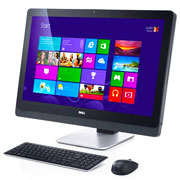
Windows 8 has failed to give PC sales the boost it was supposed to, the NPD Group has found.
Since the OS’ Oct. 26 launch, overall Windows device sales have fallen 21 percent compared with the same period last year, NPD said. Notebook sales fell 24 percent, and desktop PC sales slipped by 9 percent.
“Desktops have performed better than notebooks all year, based mostly on the popularity of all-in-one products and the niche appeal of desktops to today’s mass market consumer,” said Stephen Baker, vice president of industry analysis at NPD. “We remain optimistic that Windows computing device sales will strengthen during the holiday season.”
Behind the Win 8 Ball
In the four weeks since its launch, Windows 8 accounted for 58 percent of the Windows computing devices sold, according to the report. In comparison, Windows 7 chalked up 83 percent of Windows computing device sales four weeks after it was released in July 2009.
“After just four weeks on the market, it’s still early to place blame on Windows 8 for the ongoing weakness in the PC market,” Baker said.
One reason for Windows 8’s weak performance is the poor back-to-school sales of PCs, which left a lot of inventory in the channel. That impacted initial sell-through rates for Windows 8 devices.
However, Windows 8 notebooks with touchscreens, which take advantage of the OS’s features, did relatively well, accounting for 6 percent of Windows 8 notebook sales at an average price of US$867. That helped re-establish a premium segment in the Windows consumer notebook market.
It’s the Circumstances, Part One
Consumers’ reluctance to adopt Windows 8’s user interface, which is drastically different from that of previous versions of the OS, could be one reason for the OS’s lack of acceptance, Gartner analyst Mikako Kitagawa suggested.
“In general, the majority of consumers don’t like drastic change,” Kitagawa told the E-Commerce Times. “They don’t want to … adopt new technology if it requires extra effort in the learning process.”
Further, “most households in the United States own at least one PC, and consumers would hold off getting a new PC unless theirs is too old or has broken down,” Kitagawa pointed out. “They might allocate their money for buying a tablet instead because tablet penetration of U.S. households is low.”
Another factor is the computer market’s success over the past few years, NPD’s Baker said. “There remain a lot of relatively new systems in the market that consumers aren’t replacing.”
Circumstances, Part Two
Supply-chain issues also hit Windows 8 PC sales, David Daoud, director of research at IDC, told the E-Commerce Times.
“Makers in Asia are having a hard time turning out enough touchscreen systems above 10 inches in size,” Daoud explained. “There’s now an unusual amount of demand for larger systems and hybrids” and it’s going to take manufacturers awhile to ramp up.
Meanwhile, OEMs and Microsoft are trying to figure out just what the roadmap for Windows 8 products should be.
“No clear consensus has emerged, and that’s why you see Microsoft trying to build its own Surface tablets,” Daoud said.
This debate has had a ripple effect on retailers. “If you go to Best Buy, a retailer that accounts for the majority of brick-and-mortar [consumer electronics] sales in the U.S., you will notice that the coolest devices running on Windows 8 are missing,” Daoud pointed out. “What you find are traditional design laptops that shifted from Windows 7, but that’s it.” Consumers don’t see what they want — the new designs.
A Better Tomorrow?
Windows 8 PC sales will pick up during the holiday season, and in particular those with touchscreens will “do very well when the supply picks up and prices fall to more affordable levels,” Baker said.
IDC expects “better clarity in the industry” about the Windows 8 roadmap next year, and “there’s strong potential for improved performance,” Daoud said.
Microsoft did not respond to our request to comment for this story.






















































Social Media
See all Social Media